A Study on the Surfactant and Tribological Properties of Water-Based Nano-Rolling Lubricants on Non-Ferrous Metal Surfaces
Abstract
1. Introduction
2. Research Methods
2.1. Experimental Materials
2.2. Experimental Scheme
3. Results and Discussion
3.1. Dispersion Stability Test of Water-Based Lubricant
3.2. Wettability Test of Water-Based Lubricant
3.3. Frictional Performance Test of Water-Based Lubricants
3.4. Molecular Dynamic Simulation
4. Conclusions
Author Contributions
Funding
Data Availability Statement
Conflicts of Interest
References
- Spikes, H. Friction modifier additives. Tribol. Lett. 2015, 60, 5. [Google Scholar]
- Wang, B.; Qiu, F.; Barber, G.C.; Zou, Q.; Wang, J.; Guo, S.; Yuan, Y.; Jiang, Q. Role of nano-sized materials as lubricant additives in friction and wear reduction: A review. Wear 2022, 490, 204206. [Google Scholar]
- Vattikuti, S.P.; Byon, C. Synthesis and Characterization of Molybdenum Disulfide Nanoflowers and Nanosheets: Nanotribology. J. Nanomater. 2015, 2015, 710462. [Google Scholar] [CrossRef]
- Zhu, Y.; Zhang, H.; Li, N.; Jiang, Z. Friction and Wear Characteristics of Fe3O4 Nano-Additive Lubricant in Micro-Rolling. Lubricants 2023, 11, 434. [Google Scholar] [CrossRef]
- Wu, H.; Kamali, H.; Huo, M.; Lin, F.; Huang, S.; Huang, H.; Jiao, S.; Xing, Z.; Jiang, Z. Eco-Friendly Water-Based Nanolubricants for Industrial-Scale Hot Steel Rolling. Lubricants 2020, 8, 96. [Google Scholar] [CrossRef]
- Wu, H.; Zhao, J.; Xia, W.; Cheng, X.; He, A.; Yun, J.H.; Wang, L.; Huang, H.; Jiao, S.; Huang, L.; et al. Analysis of TiO2 nano-additive water-based lubricants in hot rolling of microalloyed steel. J. Manuf. Process. 2017, 27, 26–36. [Google Scholar]
- Yu, H.; Yi, X.U.; Shi, P.; Xu, B.-S.; Wang, X.-L.; Liu, Q. Tribological properties and lubricating mechanisms of Cu nanoparticles in lubricant. Trans. Nonferrous Met. Soc. China 2008, 18, 636–641. [Google Scholar]
- Choi, Y.; Lee, C.; Hwang, Y.; Park, M.; Lee, J.; Choi, C.; Jung, M. Tribological behavior of copper nanoparticles as additives in oil. Curr. Appl. Phys. 2009, 9, e124–e127. [Google Scholar]
- Zhang, B.S.; Xu, B.S.; Xu, Y.; Gao, F.; Shi, P.-J.; Wu, Y.-X. Cu nanoparticles effect on the tribological properties of hydrosilicate powders as lubricant additive for steel–steel contacts. Tribol. Int. 2011, 44, 878–886. [Google Scholar]
- Padgurskas, J.; Rukuiza, R.; Prosyčevas, I.; Kreivaitis, R. Tribological properties of lubricant additives of Fe, Cu and Co nanoparticles. Tribol. Int. 2013, 60, 224–232. [Google Scholar]
- Zhang, C.; Zhang, S.; Song, S.; Yang, G.; Yu, L.; Wu, Z.; Li, X.; Zhang, P. Preparation and tribological properties of surface-capped copper nanoparticle as a water-based lubricant additive. Tribol. Lett. 2014, 54, 25–33. [Google Scholar] [CrossRef]
- Li, X.; Cao, Z.; Zhang, Z.; Dang, H. Surface-modification in situ of nano-SiO2 and its structure and tribological properties. Appl. Surf. Sci. 2006, 252, 7856–7861. [Google Scholar] [CrossRef]
- Peng, D.X.; Chen, C.H.; Kang, Y.; Chang, Y.; Chang, S. Size effects of SiO2 nanoparticles as oil additives on tribology of lubricant. Ind. Lubr. Tribol. 2010, 62, 111–120. [Google Scholar] [CrossRef]
- Song, H.J.; Zhang, Z.Z.; Men, X.H. The tribological behaviors of the polyurethane coating filled with nano-SiO2 under different lubrication conditions. Compos. Part A Appl. Sci. Manuf. 2008, 39, 188–194. [Google Scholar] [CrossRef]
- Sia, S.Y.; Bassyony, E.Z.; Sarhan, A.A.D. Development of SiO2 nanolubrication system to be used in sliding bearings. Int. J. Adv. Manuf. Technol. 2014, 71, 1277–1284. [Google Scholar] [CrossRef]
- Meng, Y.; Sun, J.; He, J.; Yan, X.; Pei, Y. Recycling prospect and sustainable lubrication mechanism of water-based MoS2 nano-lubricant for steel cold rolling process. J. Clean. Prod. 2020, 277, 123991. [Google Scholar]
- Peng, D.X.; Kang, Y.; Hwang, R.M.; Shyr, S.; Chang, Y. Tribological properties of diamond and SiO2 nanoparticles added in paraffin. Tribol. Int. 2009, 42, 911–917. [Google Scholar] [CrossRef]
- Gupta, R.N.; Harsha, A.P. Antiwear and extreme pressure performance of castor oil with nano-additives. Proc. Inst. Mech. Eng. Part J J. Eng. Tribol. 2018, 232, 1055–1067. [Google Scholar] [CrossRef]
- Chiam, H.W.; Azmi, W.H.; Usri, N.A.; Mamat, R.; Adam, N. Thermal conductivity and viscosity of Al2O3 nanofluids for different based ratio of water and ethylene glycol mixture. Exp. Therm. Fluid Sci. Int. J. Exp. Heat Transf. Thermodyn. Fluid Mech. 2017, 81, 420–429. [Google Scholar] [CrossRef]
- Masuda, H.; Ebata, A.; Teramae, K. Alteration of thermal conductivity and viscosity of liquid by dispersing ultra-fine particles (dispersion of γ-Al2O3, SiO2 and TiO2 ultra-fine particles). Netsu Bussei 1993, 7, 227–233. [Google Scholar] [CrossRef]
- Iranmanesh, S.; Mehrali, M.; Sadeghinezhad, E.; Ang, B.C.; Ong, H.C.; Esmaeilzadeh, A. Evaluation of viscosity and thermal conductivity of graphene nanoplatelets nanofluids through a combined experimental–statistical approach using respond surface methodology method. Int. Commun. Heat Mass Transf. 2016, 79, 74–80. [Google Scholar]
- Sonawane, S.S.; Juwar, V. Optimization of conditions for an enhancement of thermal conductivity and minimization of viscosity of ethylene glycol based Fe3O4 nanofluid. Appl. Therm. Eng. 2016, 109, 121–129. [Google Scholar]
- Zin, V.; Agresti, F.; Barison, S.; Colla, L.; Gondolini, A.; Fabrizio, M. The Synthesis and Effect of Copper Nanoparticles on the Tribological Properties of Lubricant Oils. IEEE Trans. Nanotechnol. 2013, 12, 751–759. [Google Scholar]
- Xia, G.; Jiang, H.; Liu, R.; Zhai, Y. Effects of surfactant on the stability and thermal conductivity of Al2O3/de-ionized water nanofluids. Int. J. Therm. Sci. 2014, 84, 118–124. [Google Scholar]
- Pati, S.S.; Mahendran, V.; Philip, J. A Simple Approach to Produce Stable Ferrofluids Without Surfactants and with High Temperature Stability. J. Nanofluids 2013, 2, 94–103. [Google Scholar] [CrossRef]
- Ilyas, S.U.; Narahari, M.; Theng, J.T.Y.; Pendyala, R. Experimental evaluation of dispersion behavior, rheology and thermal analysis of functionalized zinc oxide-paraffin oil nanofluids. J. Mol. Liq. 2019, 294, 111613. [Google Scholar]
- Krishnakumar, V.; Elansezhian, R. Dispersion stability of zinc oxide nanoparticles in an electroless bath with various surfactants. Mater. Today: Proc. 2022, 51, 369–373. [Google Scholar]
- Nordin, A.H.; Ahmad, Z.; Husna, S.M.N.; Ilyas, R.A.; Azemi, A.K.; Ismail, N.; Nordin, M.L.; Ngadi, N.; Siti, N.H.; Nabgan, W.; et al. The State of the Art of Natural Polymer Functionalized Fe3O4 Magnetic Nanoparticle Composites for Drug Delivery Applications: A Review. Gels 2023, 9, 121. [Google Scholar] [CrossRef]
- Zhu, Y.; Zhang, H.; Li, N.; Jiang, Z. Preparation, Characterization, and Lubrication Performances of Water-Based Nanolubricant for Micro Rolling Strips. Materials 2024, 17, 516. [Google Scholar] [CrossRef]
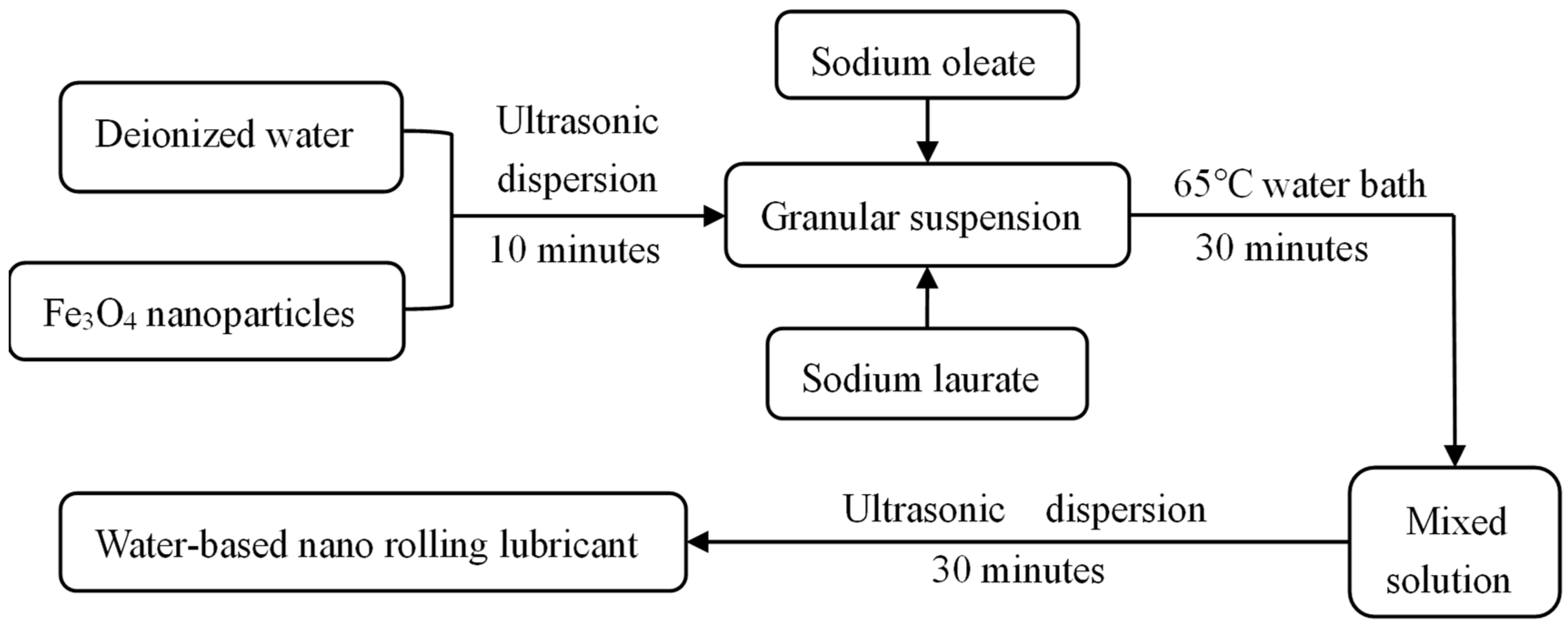
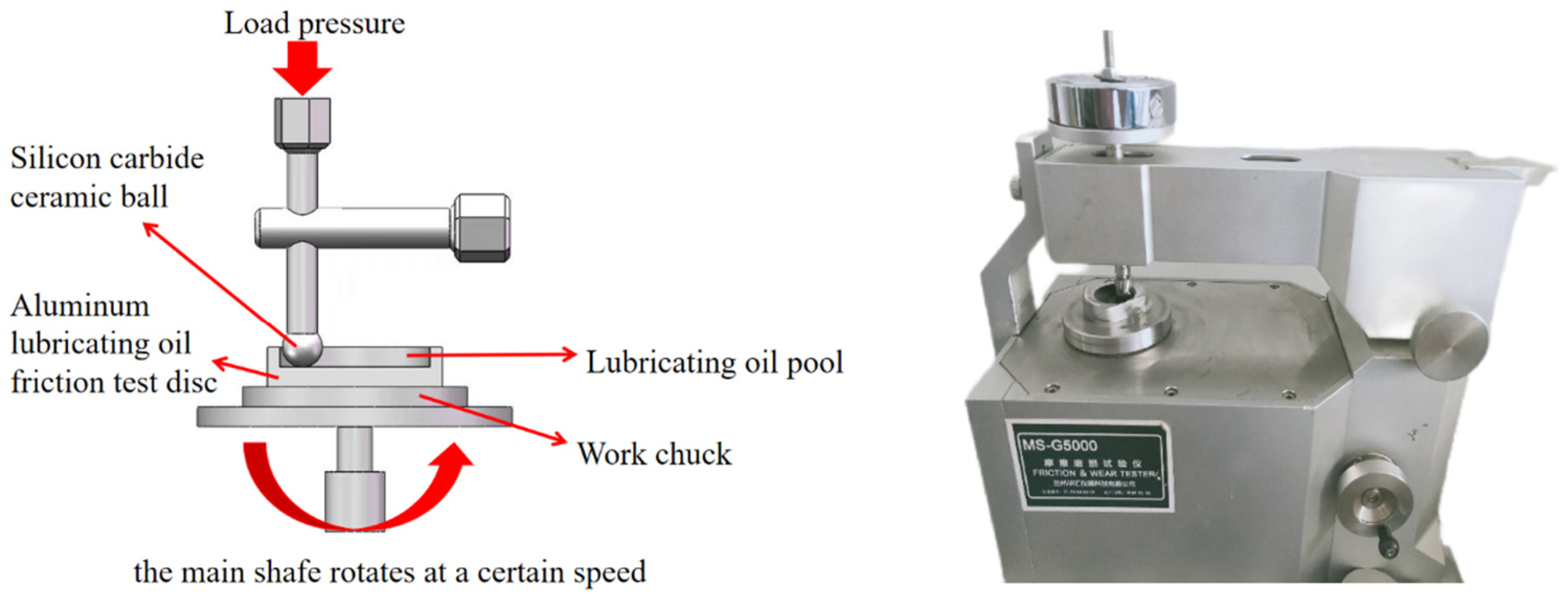

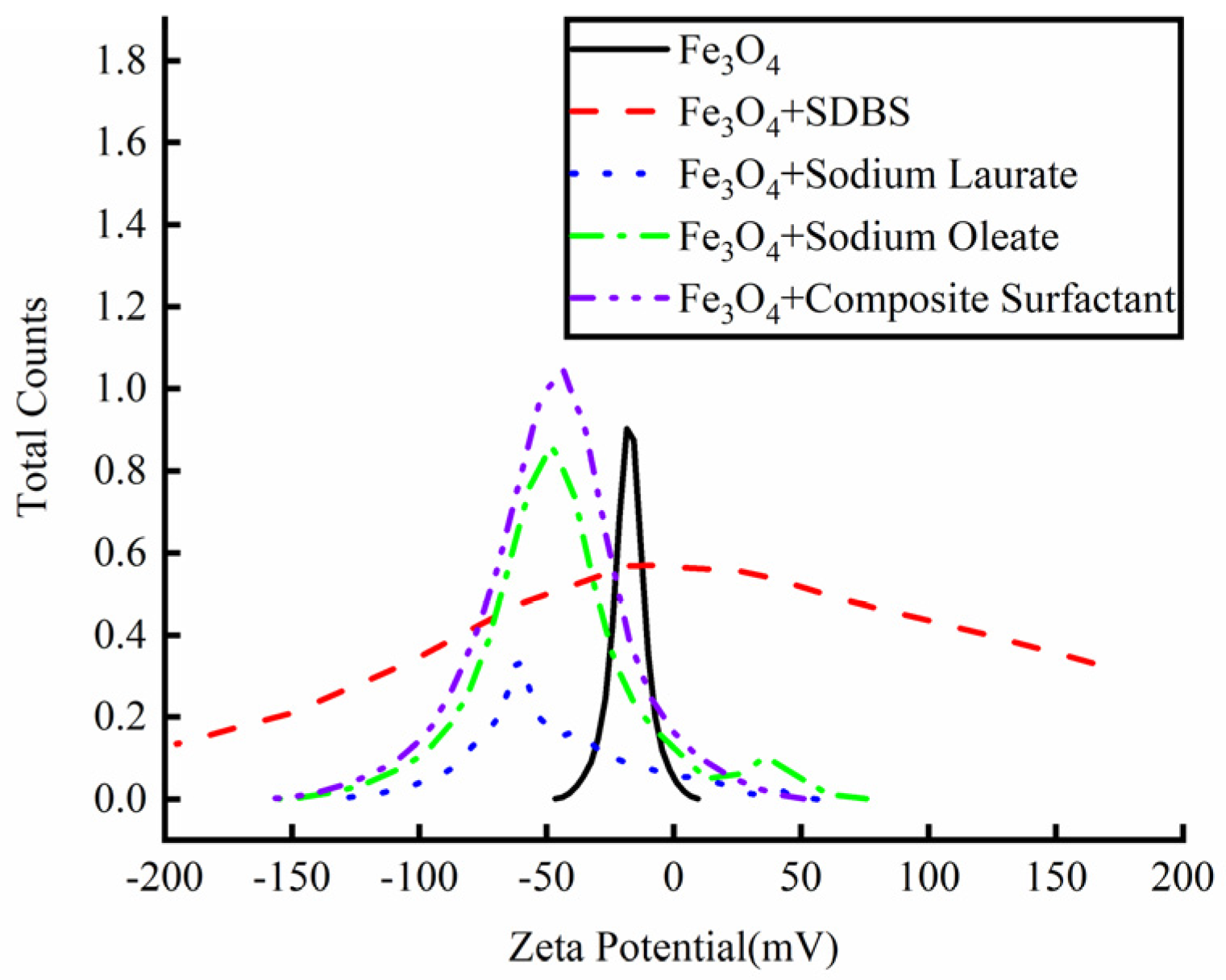
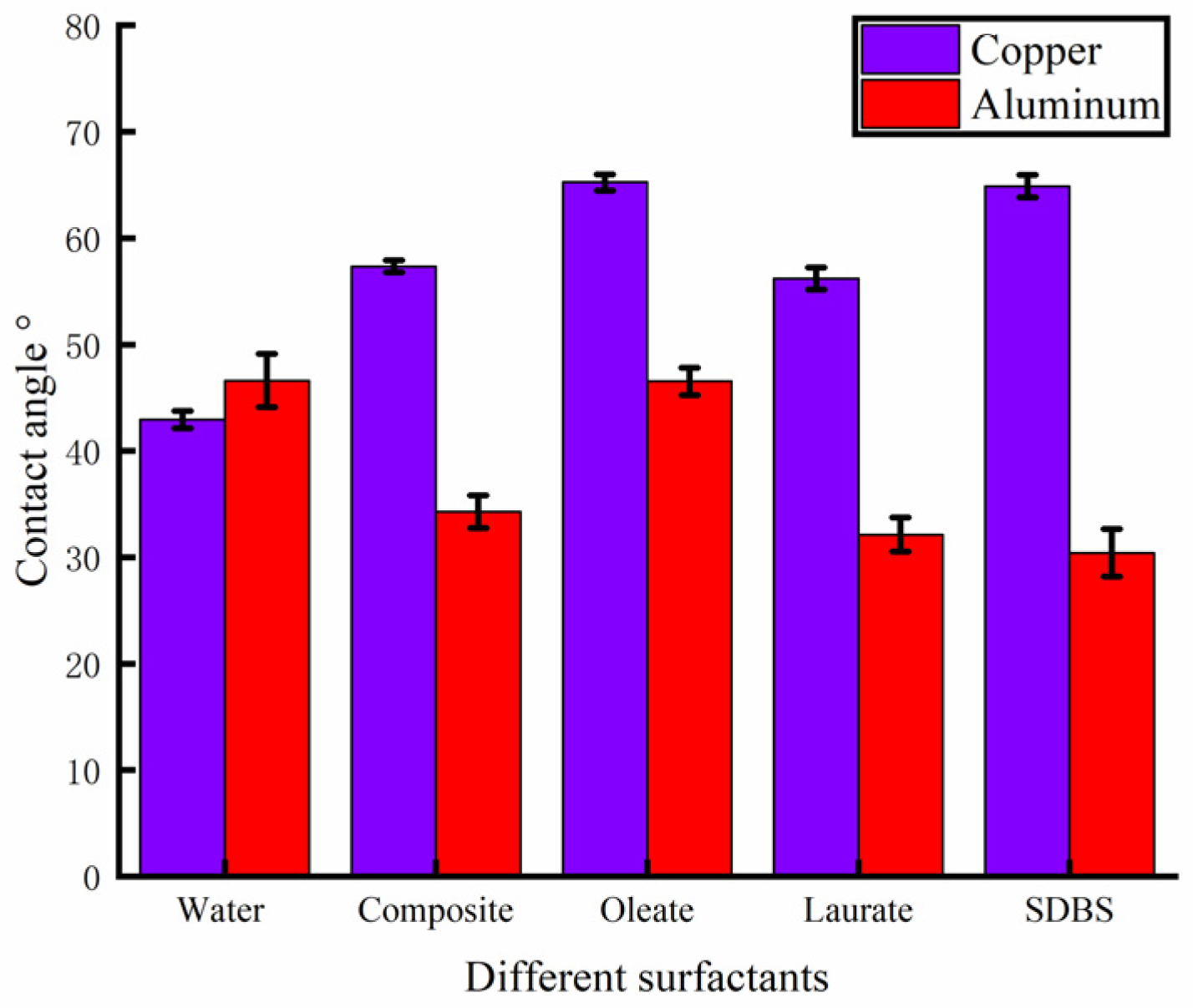
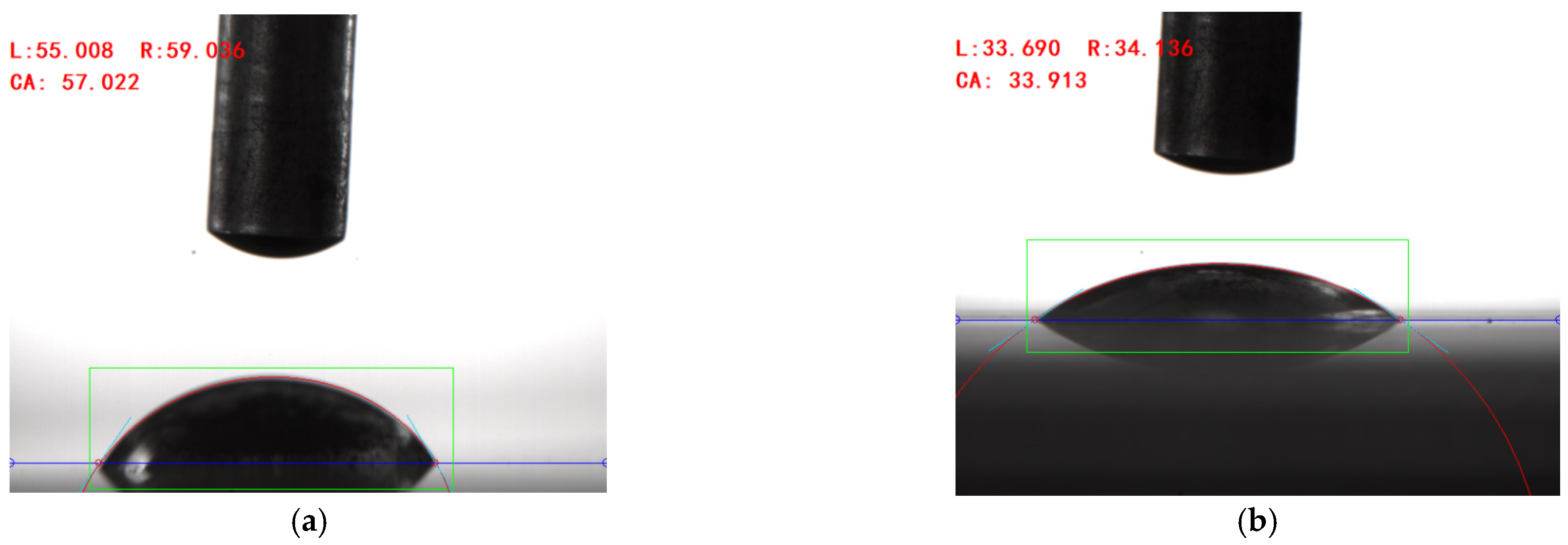
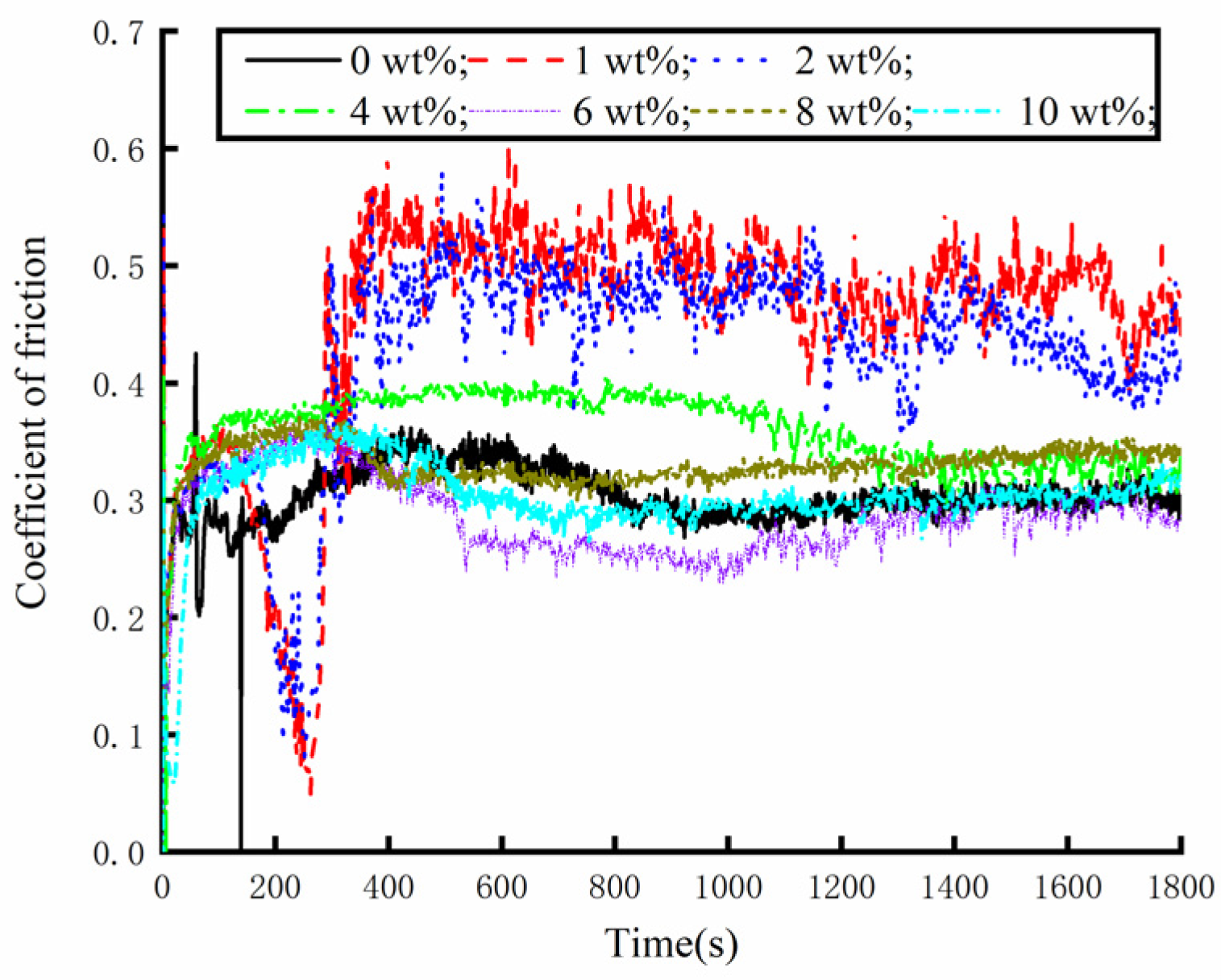
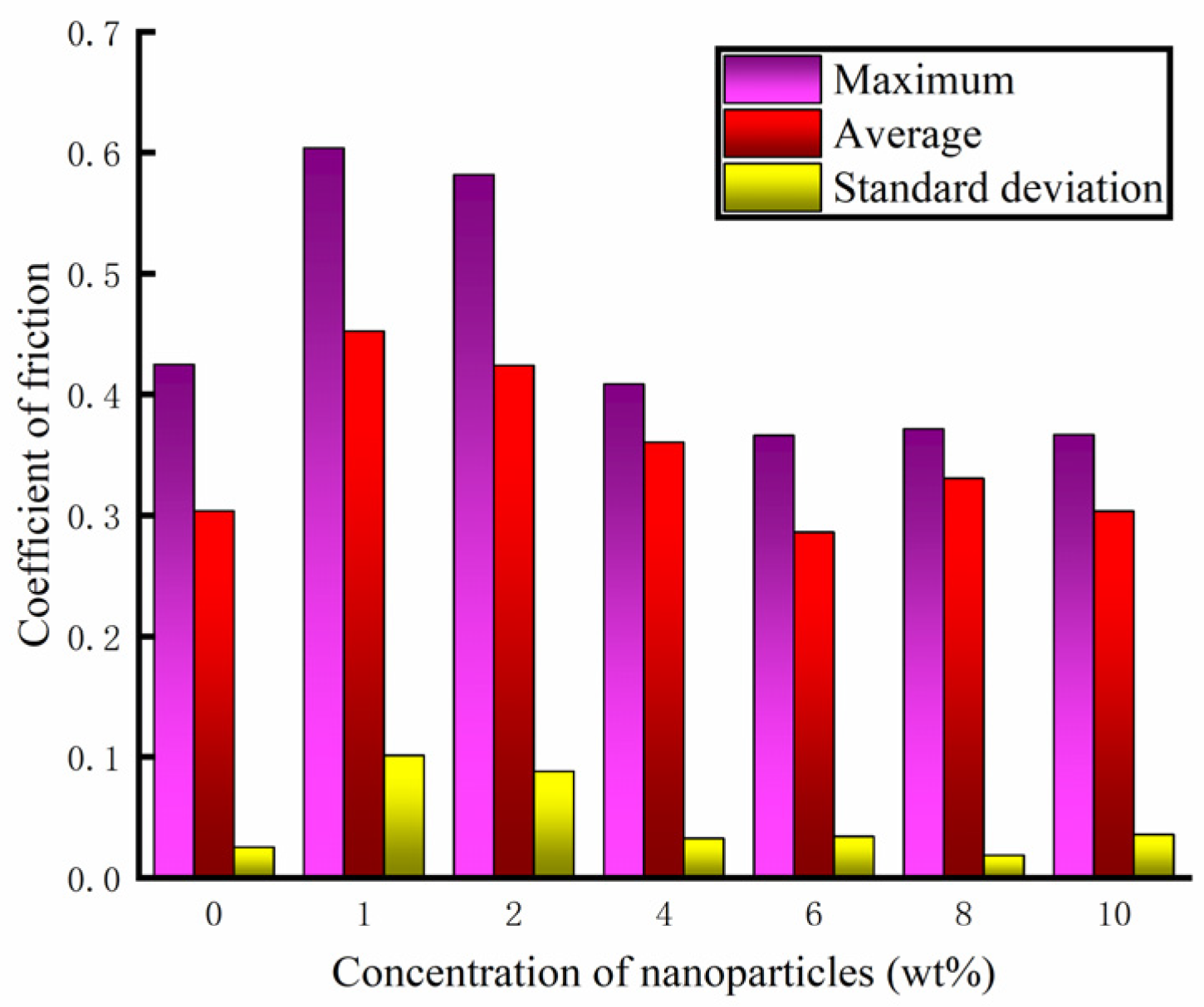
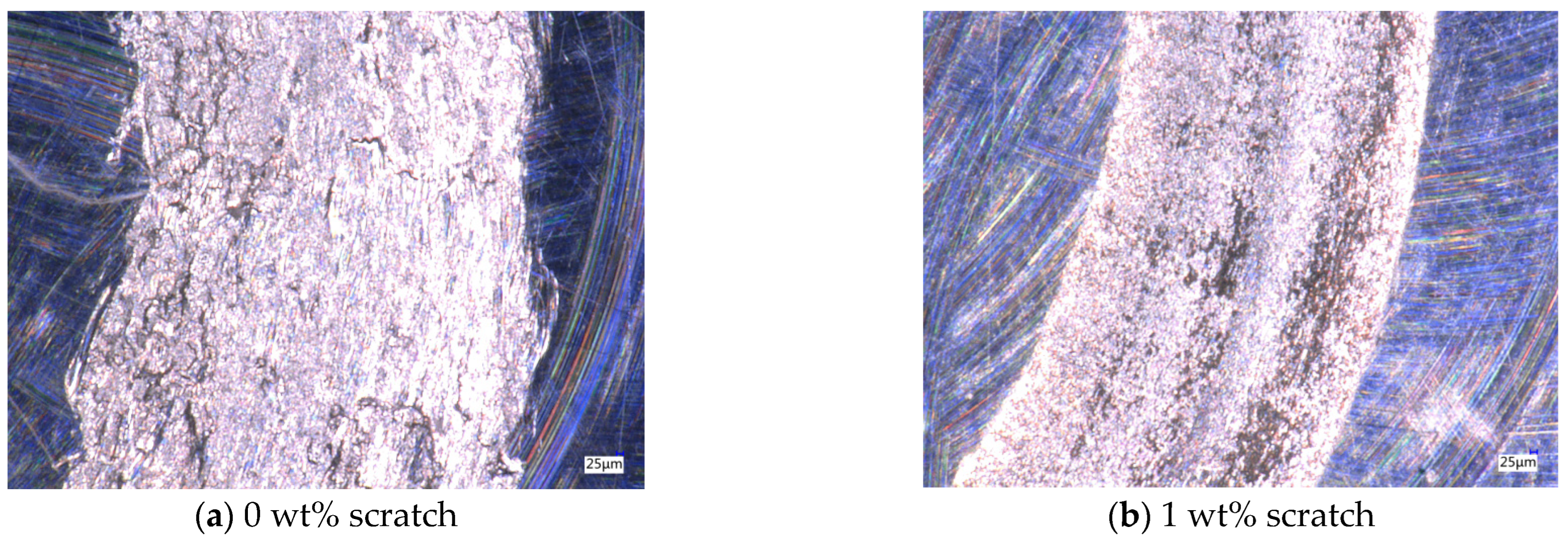
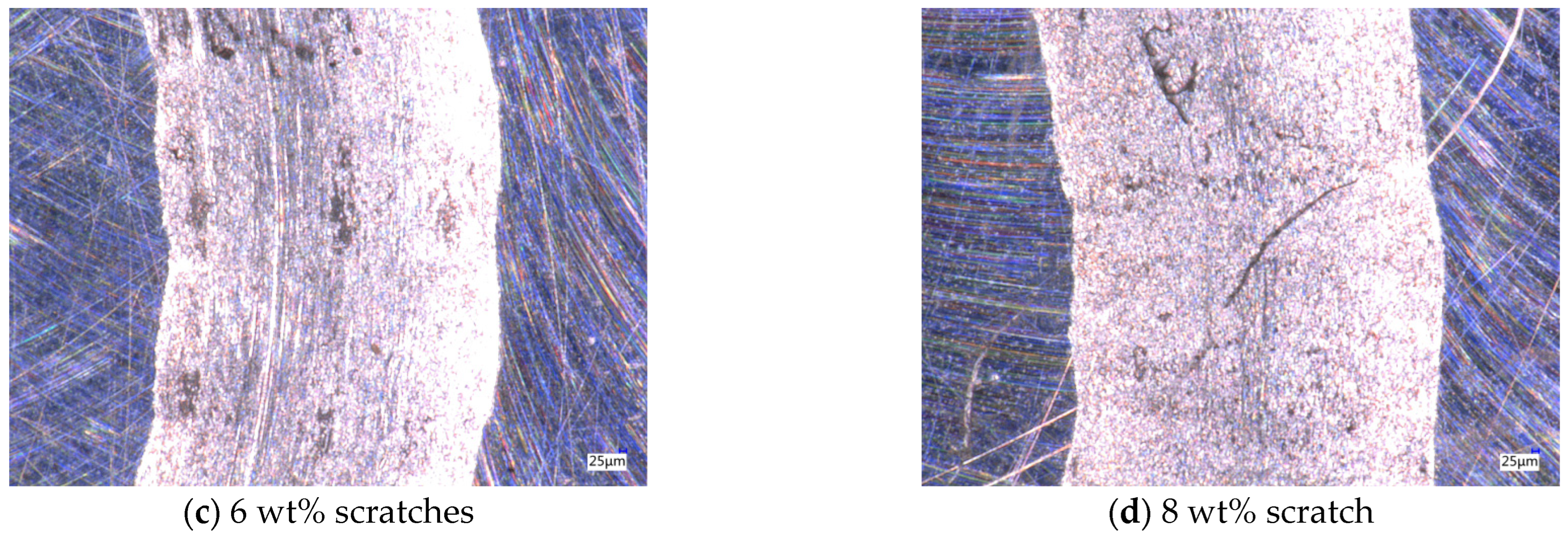

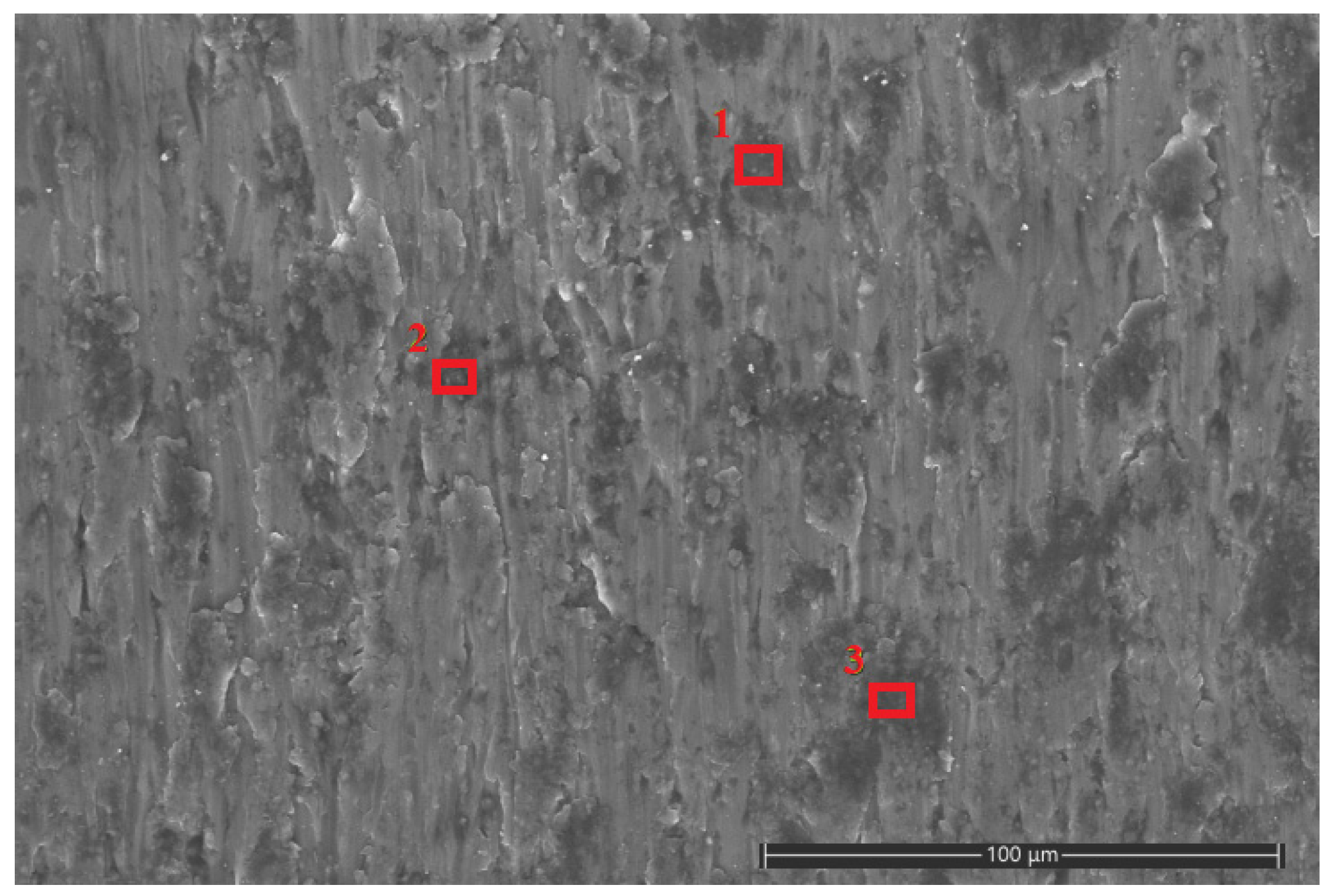


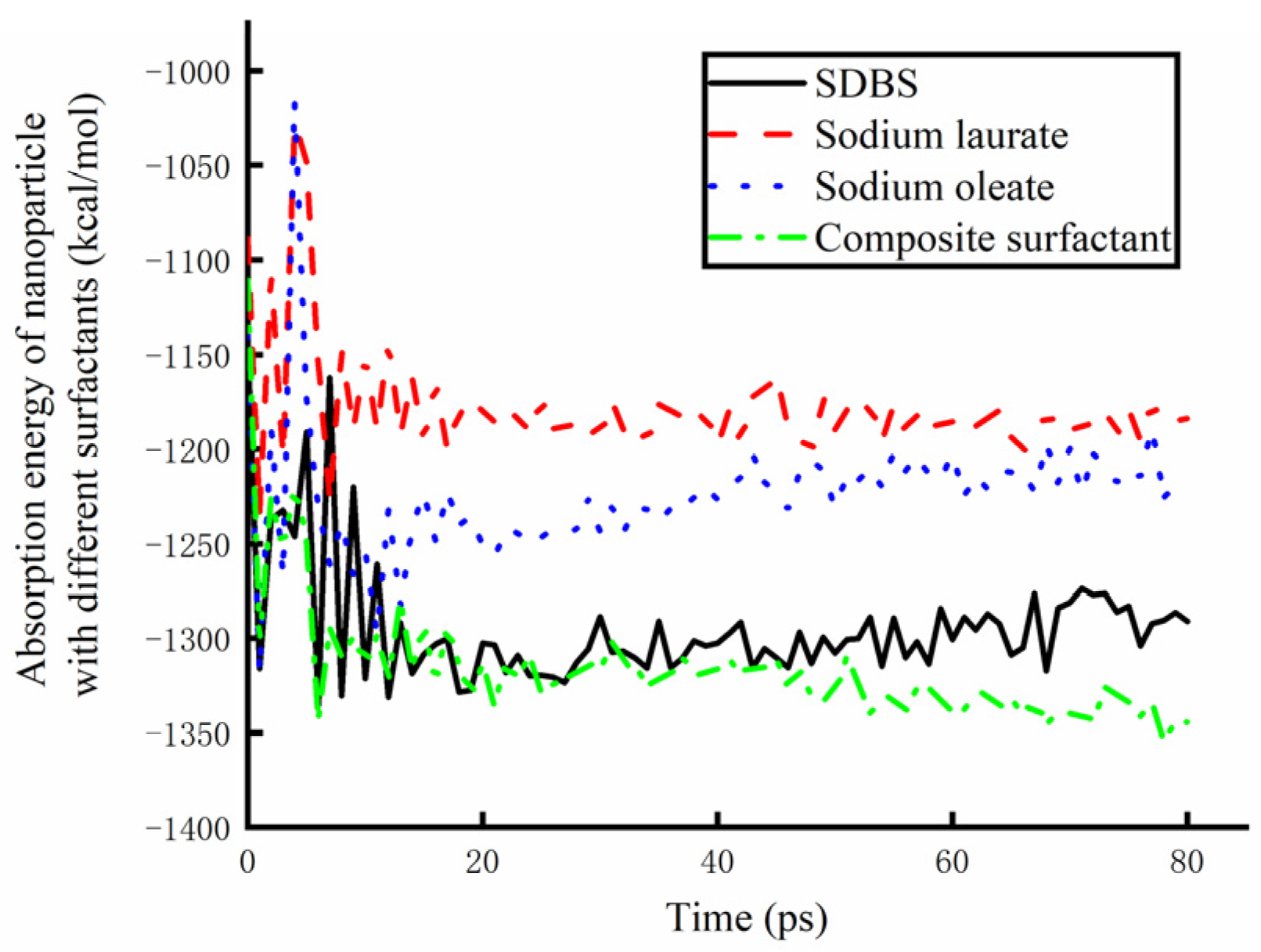
| Name | Crystal Form | Diameter (nm) | Purity | Shape | Specific Surface Area (m2/g) | Density (g/cm3) |
|---|---|---|---|---|---|---|
| Nano-Fe3O4 | ball | 20 | >99.9% | ball | 78.37 | 5.18 |
| Name | Molecular Formula | Relative Molecular Mass | Analytic Ally Pure | Sort | Purpose |
|---|---|---|---|---|---|
| Sodium oleate | C18H33NaO2 | 304.44 | 98% | Reagent | surfactant |
| Sodium laurate | C12H23NaO2 | 222.3 | 98% | Reagent | surfactant |
| SDBS | C18H29NaO3S | 348.476 | 98% | Reagent | surfactant |
| Item | Load (g) | Rotate Speed (r/min) | Friction Force | Sample Thickness (mm) | Sample Size (mm) |
|---|---|---|---|---|---|
| Testing range | 100–2000. | 1–3000. | 0–10 N | 1–10 | ϕ 10–ϕ 53 |
| Element | Point 1 (wt%) | Point 2 (wt%) | Point 3 (wt%) |
|---|---|---|---|
| C | 8.0 | 18.5 | 6.6 |
| O | 31.6 | 13.5 | 33.2 |
| Al | 60.1 | 67.1 | 59.0 |
| Fe | 0.3 | 0.9 | 1.2 |
Disclaimer/Publisher’s Note: The statements, opinions and data contained in all publications are solely those of the individual author(s) and contributor(s) and not of MDPI and/or the editor(s). MDPI and/or the editor(s) disclaim responsibility for any injury to people or property resulting from any ideas, methods, instructions or products referred to in the content. |
© 2025 by the authors. Licensee MDPI, Basel, Switzerland. This article is an open access article distributed under the terms and conditions of the Creative Commons Attribution (CC BY) license (https://creativecommons.org/licenses/by/4.0/).
Share and Cite
Zhu, Y.; Li, Z.; Han, C. A Study on the Surfactant and Tribological Properties of Water-Based Nano-Rolling Lubricants on Non-Ferrous Metal Surfaces. Lubricants 2025, 13, 152. https://doi.org/10.3390/lubricants13040152
Zhu Y, Li Z, Han C. A Study on the Surfactant and Tribological Properties of Water-Based Nano-Rolling Lubricants on Non-Ferrous Metal Surfaces. Lubricants. 2025; 13(4):152. https://doi.org/10.3390/lubricants13040152
Chicago/Turabian StyleZhu, Yuchuan, Zixuan Li, and Changyu Han. 2025. "A Study on the Surfactant and Tribological Properties of Water-Based Nano-Rolling Lubricants on Non-Ferrous Metal Surfaces" Lubricants 13, no. 4: 152. https://doi.org/10.3390/lubricants13040152
APA StyleZhu, Y., Li, Z., & Han, C. (2025). A Study on the Surfactant and Tribological Properties of Water-Based Nano-Rolling Lubricants on Non-Ferrous Metal Surfaces. Lubricants, 13(4), 152. https://doi.org/10.3390/lubricants13040152




